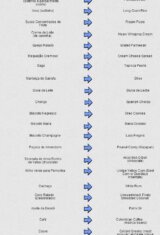A Useful Grocery List of Brazilian Food Products with their American Substitutes is finally here, which hopefully will make life easier for many!!! Find out the equivalent of Brazilian products in the United States and vice-versa!

Friends, bloggers, and followers often ask me which American product would be a suitable substitute for a particular Brazilian product -- since some items are not available at local American supermarkets. I used to respond to such questions individually; however, this list of Brazilian food products with their American substitutes will address many questions all at once.
Some of the Brazilian food products listed here have exact American equivalents, while others have only a rough counterpart that will work in a pinch (um quebra-galho). For more detailed information, please read the explanations beneath this useful grocery list of Brazilian food products with their American substitutes.
Grocery Shopping List
- Polvilho Doce: Need to make pão de queijo (Brazilian cheese bread) or other traditional Brazilian foods like tapioca breadsticks from scratch? Don't worry! You don't need to go to a Latin or Asian market, or even order polvilho doce online... It is available in the US from various brands under the name Tapioca Flour (or tapioca starch). One of the best-known brands is Bob's Red Mill, which is available in many local supermarkets.
- Polenta, Angú, or Xerém: Its American equivalent is Coarse Polenta or Coarse Cornmeal. There is the regular type of yellow cornmeal, with a fine texture, which is not the same as our Brazilian polenta. Look for coarse polenta or coarse cornmeal.
- Amido de Milho ou Maizena: Its American equivalent is simply cornstarch -- which is available in the baking aisle of every single American supermarket. 🙂
- Fermento em Pó: This is another product that is quite easy to find. In the US, it is available by the name of baking powder. [Please do not confuse this with baking soda (or bicarbonato de sódio). Bicarbonato de sódio is often used in American baking recipes to neutralize acids such as buttermilk and sour cream. It is something seldom used in Brazilian recipes and our grocery list.]
- Guaraná (refrigerante): I am so sorry! There is no exact equivalent in the US for our guaraná soda. When I cannot find guaraná soda in Latin supermarkets or at the Walmart Latin aisle shelves, I get Ginger Ale instead. Of course, they do not have quite the same flavor, for obvious reasons: guaraná is a guaraná fruit-flavored soda while ginger ale is a ginger-flavored soda. But although they do not taste the same, ginger ale is about the closest counterpart that one finds for guaraná.
- Queijo de Coalho: There is no cheese available in the US quite like our queijo de coalho. Queijo de coalho is a firm cow's milk cheese produced in Northeastern Brazil, producing an almost 'squeaky' sensation when bitten into. If you cannot order this online, you may still be able to find something that comes close to it in taste: Halloumi cheese. This semi-hard cheese from Cyprus has a mixture of goat's and sheep's milk (and sometimes also cow's milk), and provides a wonderful substitute because it is similar to queijo de coalho both in taste and especially texture. Just like our queijo de coalho, Halloumi cheese is set with rennet. If you grill or griddle slices of either of the two cheeses in a bit of oil or butter, they develop a crunchy texture outside and a delicious melted inside. However, Halloumi is considerably saltier than our queijo de coalho, so I do recommend submerging Halloumi in a bowl of cold water for 1 hour, changing the water once or twice, patting dry with a clean kitchen towel or paper towel, and then cooking as desired. Halloumi is available in Middle-Eastern markets, Whole Foods, and possibly your local gourmet grocer. Both queijo de coalho and halloumi make great grilling cheeses. Add it to your grocery shopping list!
- Queijo de Minas (tipo frescal): Minas cheese is traditionally produced in the Brazilian state of Minas Gerais. It comes in three varieties, frescal (fresh), meia-cura (slightly matured) and curado (matured). A fourth variety, queijo padrão (standard cheese), has been produced more recently and can be easily found in supermarkets in Brazil. The most suitable US substitute for queijo de minas (tipo frescal) is Mexican queso fresco -- which is a cow's milk-based, white, fresh cheese used in Mexican cooking. It is sold by different brands and it is a bit saltier than our queijo de Minas. You may find it in your supermarket cheese or yogurt aisle, or Costco.
- Carne Seca: Carne seca is a type of jerky. The most similar US product is beef jerky -- which is drier and sliced thinner than carne seca. However, if you rehydrate beef jerky in boiling water, it becomes similar to our carne seca although still not as thick as carne seca. [Note: please do not confuse this with carne de sol (or sun-cured beef). To learn more about carne de sol and to find out how to make it from scratch, get the recipe for carne de sol.]
- Picanha: To get this Brazilian meat cut, ask your butcher for Top Sirloin Cap. To prepare an easy and delicious picanha in the oven, get the recipe picanha roast or grilled picanha steak. Check out our Meat cuts of beef for Brazilian and American cuts. Add it to your grocery list!
- Arroz Parbolizado: This is available in every American supermarket by the name Parboiled Rice. It is partially cooked with loose grains (soltinho).
- Arroz (soltinho): It is a long-grain rice available under different brand names. Because its grains contain less starch than medium or short-grain rice, it stays loose once cooked.
- Sucos Concentrados de Fruta: If you cannot find bottled concentrated tropical fruit juices at Latin supermarkets, you could take advantage of frozen fruit pulps. Goya is a Latin brand available in both American (e.g. Walmart) and Latin supermarkets. It offers frozen tropical fruit pulps in a similar range of flavors as ours, such as passion fruit (maracujá), guava (both white and red goiaba), papaya (mamão), mango, guanabana (graviola), etc. Let the pulp thaw and then use it for refreshing juices, fruit mousses, and other desserts.
- Requeijão Cremoso: Just as various brands of our requeijão or Brazilian cream cheese spread have a similar texture but vary in flavor -- and each person has their favorite-- it might not be a problem to try the Arabian Puck Cream Cheese Spread. Just about every Middle-Eastern market sells this.
- Creme de Leite: As a substitute for our canned creme de leite, there is Nestle Media Crema: check the Hispanic food aisle of your supermarket. For our creme de leite em caixinha, there is the American heavy whipping cream, available in the refrigerated dairy aisle which is the fresh version. Although not exactly the same, both the canned and carton forms are similar in taste and somewhat similar in texture to our creme de leite. For those who intend to use this list in reverse, please don't use 'creme de leite' (canned or in carton) to prepare whipped cream because it contains less fat than heavy whipping cream (which is a fresh product). Brazilians use 'creme de leite' in many sweet and savory dishes such as pasta, stews, and on top of guava paste (goiabada) as a snack. If you are in the U.S., you can use heavy cream to prepare the same Brazilian dishes that call for 'creme de leite'. I do not like to use 'half & half' in dishes that call for 'creme de leite' because it is thinner than 'creme de leite'.
- Queijo Ralado: Look for grated Parmesan cheese. But be aware that our queijo ralado tends to be more flavorful and saltier than the grated parmesan cheese often sold in American supermarkets. Another more suitable option is to add it to your grocery list and buy a block of good-quality Parmesan cheese and grate it right before using.
- Sagú: Look for tapioca pearls. Americans use tapioca pearls to make tapioca pudding. Tapioca pudding and sagú are essentially the same. The difference is that in Brazil we often use red wine or fruit juice (maracujá or passion fruit) to prepare sagú or red wine tapioca pudding, while Americans basically use the same ingredients as those for making rice pudding or arroz doce (milk, sugar, cinnamon, etc.) in order to make tapioca pudding.
- Manteiga de Garrafa: Manteiga-de-garrafa ('butter-in-a-bottle'), also known as manteiga-da-terra ('butter of the land'), is a product from Northeastern Brazil that refers to a clarified butter product, similar to Indian ghee. Ghee is available in Asian markets all over the US as well as at Walmart.
- Doce de Leite: Known in the US as dulce de leche. It is available in the Hispanic/Latin aisle of many American supermarkets. Nestle La Lechera sells one similar to our doce de leite Nestlé. List here...
- Chouriço: Would you like to prepare feijoada? The most similar sausage to Brazilian and Portuguese chouriço is Spanish chorizo (not Mexican chorizo, since this uses chilies instead of paprika).
- Biscoito Negresco: Although Negresco (round chocolate sandwich cookies with a vanilla-flavored filling) is from Nestlé Brasil while Oreo cookies are from the American company Nabisco, the truth is their appearance is quite similar. In terms of taste, each person has his/her own opinion. Mine is they taste somewhat similar -- although not exactly the same. 🙂 Oreos have a dark chocolate flavor while Negresco has more of a semisweet chocolate flavor. List here...
- Biscoito Maria: Maria cookies are available in the Latin aisle of many American supermarkets. Goya is one of several companies that manufacture this product in the US, Mexico, and some South American countries.
- Biscoito Champagne: Known in the U.S. as lady fingers, the ones imported from Italy are less sweet and a bit softer than Brazilian and American ladyfingers.
- Paçoca de Amendoim: Only recently did I find a great substitute for our paçoca de amendoim. Its name is Peanut Candy Mazapan, marketed by the brand La Molienda. I came across this by chance at a Mexican market when I had to develop a recipe for the Latin Kitchen, my paçoca ice cream with fried bananas and chocolate sauce. If you cannot find paçoca de amendoim or Peanut Candy Mazapan to make a dessert, don't worry. Roast and then grind peanuts (mix with a bit of sugar if desired) in order to use in paçoca mousse, ice cream, or other dessert recipes. make sure to add it to your grocery list!
- Serenata de Amor/ Sonho de Valsa: Both the chocolate bonbons Serenata de Amor and Sonho de Valsa contain a cashew nut cream filling. Although Arcor Bon O Bon has a peanut cream filling, it is the chocolate bonbon most similar in taste, texture, and appearance (cream and wafer covered with milk chocolate) to our chocolate bonbons.
- Milho Verde: If, like me, you have tried to make pamonhas (Brazilian yellow corn tamales) and the recipe went very wrong, it is not your fault! Blame the American sweet yellow corn (at least the most common variety sold in the US) which is high in sugar and low in starch. To make our pamonha in the US, you will need one of these two varieties of corn: Flour Corn (Zea Mays Amylacea) -- not corn flour please, or Dent Corn (Zea Mays Indentata). These two varieties are high in starch (amido), essential for getting pamonhas to solidify when boiled. Ask for unripe yellow dent corn or flour corn. Local producers/farmers may have these available.
- Cachaça: This is not overly hard to find anymore due to the widespread popularity of caipirinha. But at any rate, you can replace it with white rum -- although white rum and cachaça are not the same.
- Coco Ralado: In Brazil, coconut flakes are available finely shredded and desiccated or dehydrated. Although most American supermarkets sell sweetened coconut flakes (the flakes are larger than ours, sweet, and not desiccated), it is still possible to find a product similar to ours, such as this unsweetened, finely shredded coconut. Whole Foods Market may carry this type of product.
- Azeite de Dendê: Known as palm oil or red palm oil, this is a staple in Bahian cuisine, used for making dishes such as shrimp soup and Moqueca. This product is available in Brazilian, African, and Southeast Asian markets, and also online. You won't regret to have added it to your grocery shopping list!
- Café: Most of our Brazilian coffee beans are Arabica-type beans. Colombian coffee blends with Arabica beans are available at American supermarkets, and can be as strong as our coffee blends.s
- Couve: In American supermarkets, there are two types of couve: "collard greens," which correspond to the type of couve most commonly used in Brazil, and "kale," which corresponds to couve crespa.
- Leite de Coco: The most similar types to our leite de coco in terms of taste and thick creamy texture are Thai coconut milk, organic coconut milk, or coconut cream (NOT cream of coconut).
- Farinha de Mandioca: The Latin brand Goya sells this product as "Manioc flour" which is available at Latin supermarkets and online, and also at some American supermarkets (Hispanic food aisle). Manioc flour is the main ingredient for farofa.
- Massa para Pastel: For both baked and fried pastéis, many Latin brands sell the dough by the name 'masa para empanadas,' which is available in the freezer aisle of some American supermarkets (e.g. Walmart), Latin markets, and online. Wonton wrappers (usually available in most American and Asian grocery stores in the fresh produce section, or sometimes in the freezer aisle) make great mini pastel frito (mini fried empanadas).
- Paio: It is a smoked sausage made from pork loin, garlic, salt, and Capsicum pepper. Paio can be substituted by any smoked garlic pork sausage, or the Polish kielbasa -- available at American supermarkets.
- Lombo Defumado: Next time that you need to make feijoada, look for smoked pork loin at American supermarkets. List here.
- Linguiça Calabresa: Italian spicy Calabrese sausage is the most suitable substitute for our linguiça calabresa. It is available at American supermarkets. Calabrese sausage was introduced to Brazilians by Italian immigrants and is particularly used in pizzas, sandwiches, and feijoada.
- Queijo Prato: This Brazilian soft cheese is characterized by its yellow color, mild flavor, and low sodium content. It is similar to the Danish Danbo cheese. In fact, queijo prato was introduced by Danish immigrants in the Minas Gerais. Danbo cheese is available at specialty cheese shops in the United States.
- Flocão de Milho: Unfortunately there is no readily available exact US substitute for flocão. If you want, you can try to make cuzcuz de milho (cornmeal couscous) using a coarse corn meal, like the one Vitamilho used to produce decades ago. It will neither be as fluffy as the cuscuz made from flocão nor as quick to cook but one will still have a taste of cuscuz de milho.
- Polvilho azedo (Sour Starch): Again, there is no similar, readily available US substitute. This is a fermented starch extracted from cassava that is coarser than tapioca flour (polvilho doce). It makes pão de queijo and also tapioca crepes. However, it's available at some Latin markets or purchased online.
- Chocolate Easter Eggs (Ovos de Páscoa): Cadbury and other brands sell chocolate Easter eggs -- both mini and large sizes -- at American supermarkets.
- Panetone Bauducco: It is available at Walmart supermarkets and Walgreens Pharmacies -- both on Christmas and Easter time. Or you can make this copycat homemade panettone.
This grocery list of Brazilian food products is just a sampling. I tried to remember as many as I could, but I know that there are still other items left off of this list of Brazilian food products. If you have any additional questions, I would be happy to try and help you find an American equivalent or suitable substitute for a Brazilian food product. List!
Thanks for stopping by... and spreading the word!!! There are many Brazilians living in the US (and people from other nationalities that have lived or traveled in Brazil) and miss our products. I know that all of them would be happy to have this grocery list of Brazilian food products with their American substitutes in hand. It took me many years to find suitable American substitutes. I am so glad to be able to share them with you!
P.S.: Are there any product(s) that you don't see on the list?
Other food lists
- PCOS Diet and Food List
- 30 High-Fiber Recipes (with Food Lists)
- Cheapest Foods to Buy When Broke









Clara says
Post super útil! Obrigada!!!
Denise Browning says
So happy to know it was useful for you!
Amanda says
Hey everyone!
If your want Linguiça Calabresa. It’s better look for kielbasa than sausage. It’s more similar.
My recommendation: Polska Kielbasa. It’s the same taste.
Jim says
For Catupiry, I've always used a very mild, creamy brie with the rind removed. Just the soft insides.
Denise Browning says
Hi Jim! Although brie is a soft cheese, it is not as soft as the Brazilian catupiry cheese which is a spread. Brie also has a stronger flavor. But if you don't find it because it is not very common in the U.S., brie can help somehow. I make my own at home. We have a recipe for requeijao in the blog.
Agatha says
You can make homemade catupiry with some ingredients. I am Brazilian and own a bakery and have tried making it myself and it worked out perfectly. Just YouTube its
Eduardo says
Ola! Ótimo artigo. Alguém sabe qual é a alternativa mais similar para a nossa linguiça toscana para churrasco? Ja tentei algumas Italians sausages porem nao achei muito boa. Obrigado
Denise Browning says
Ola Eduardo! Aqui nos EUA a linguica mais similar a toscana eh a 'mild Italian sausage'. Compre uma de boa qualidade.
HC says
Hola es la primera vez que leo su blog y me encanto. Me encanta tambien esa lista de ingredients. Muy util! Muchas gracias!
Charlotte says
I've been searching in Google for these for years!
It is so helpful. Tomorrow I'm making Dadinhos de Tapioca, CANNOT WAIT.
Obrigada Denise!
Denise Browning says
My pleasure Charlotte! I have collected more subs after i wrote this list. If you need something else that is not in this list, i will be happy to help. Love dadinhos de tapioca! Have an awesome day!
Cleide says
Ola! GOstaria de saber se consigo encontrar pó para maria mole? Vc já encontrou?
Denise Browning says
Ola. Cleide! O mais similar a maria mole que ja encontrei aqui nos EUA foi marshmallow. No Whole Foods ha uns que vem no sabor de coco e tem uma textura mais mole, mais similar ao nosso do que o marshmallow industrializado vendido em outras redes de supermercados. Espero que isso ajude!
Cristina says
Hi Denise!
Onde eu posso encontrar cachaca aqui? Vc falou que white rum e' semelhante, mas eu queria o negocio de verdade, kkk
Obrigada!
Denise Browning says
Ola, Cristina!!!! Que bom ter vc visitando o nosso blog. Eu em geral compro cachaca em lojas locais que vendem wine and spirits. As maiores ou que sao parte de uma rede em geral tem cachaca. Veja se ha um Spec's (loja de rede de bebidas) em sua cidade. La ha varias marcas de cachaca. Eu compro a minha la.
Cristina says
Moro em Virginia. Vou procurar sim. Obrigada!
Elaine Schiefer-Feria says
Denise querida!!!
Obrigada por sua valiosissima informaçao...
Estou aqui nos US em janeiro farao 35 anos e numca me interessei por achar muitos substitutos aos produtos brasileiros. Mas foi muito agradavel encontrar voce e tudo que voce esta compartindo com os brasileiros aqui! Muito joia de tua parte! Ja imprimi uma copia para mim!!
Estou compartindo essa informaçao com varias brasileiras de minha cidade e tambem Liked sua Facebook pagina!
Tambem assinei para receber emails...
abraços carinhosos e mais uma vez OBRIGADA!!!!!!
Denise Browning says
Elaine, querida, o prazer eh todo meu. Fico feliz em saber que essa lista ha sido util para muita gente. Obrigada pelo carinho e por passar adiante essa lista. Espero receber mais visitas suas. Um enorme abraco!!!